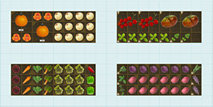How to grow Kohlrabi?
- Latin Family: Brassicaceae
- Latin Genus: Brassica
- Ease of Growing: Moderate
- Growing Type: Annual
This somewhat bizarre looking vegetable is relatively rare in gardens and kitchens, in fact most people don't even know what it is. Those who are familiar with it, consider it one of the best tasting of all the Brassicas. The edible part of the kohlrabi is not a root, but the swollen above ground portion of the stem, which tastes like a turnip.
Kohlrabi is actually a very useful crop, fast growing, compact, nutritious and slightly more tolerant of warm weather than most Brassicas. Much that has been said about cabbage also applies to kohlrabi.
Kohlrabi History
The name kohlrabi comes from the German Kohl for cabbage and Rabi for turnip, which leads some to believe that it was created as a cross between the two plants. Whether or not that is true, it certainly looks like both a cabbage and a turnip. It was probably developed in northern Europe during the late 15th or early 16th Century.
Soil Preference
- PH (min/max): 6.0 - 7.0
- PH Ideal (min/max): 6.4 - 6.6
Kohlrabi likes a light, rich, moisture-retentive soil, with lots of organic matter.
How to care for Kohlrabi?
Kohlrabi must grow fast for the best quality, so give the plants all the water and nutrients they need.
Water
Keep the soil evenly moist or the bulbous stems may turn woody. Fortunately this isn't often an issue with this cool weather crop.
Fertilizer
Low nitrogen. High potassium. High phosphorous. It's a light feeding crop and doesn't need a lot of nitrogen, but it does like potassium (add greens and or wood ashes). It also likes calcium.
Seeds
Seed Viability: 4 - 5 Years
Germination Percentage: 75.0
Like Cabbage, Kohlrabi is a biennial and takes two years to produce seed. Don't save seed from plants that flower in their first year, as you don't want to raise an annual strain that [bolts] quickly. Most Brassicas are usually self-incompatible and must be cross-pollinated by insects. This means there must be a number of plants flowering at the same time. All of the Cole crops are the same species and will cross with each other. To maintain racial purity you have to ensure that only one type flowers at once. The alternative is to isolate them, either by distance (1000 yards for different varieties, 1500 yards for different crops), or by caging them (don't forget they need insects for pollination).
In very cold climates you may have to lift the plants in fall and store them in a root cellar over the winter. Re-plant them in spring when it warms up.
Light
Sun: min. 6 hours daily
Full sun.
Conditions:Cold, Cool
Season:Short Season, Long Season
Storage
Kohlrabi will keep for several weeks in a plastic bag in a refrigerator.
Storage Req: Refrigerator
Storage Temp: 35-40°F
Storage Length: 1-14 days
Problems
Boron deficiency
All plants of the Cabbage family are susceptible to boron deficiency, which manifests itself as hollow stems. Compost should supply the plants with all the boron they need.
Kohlrabi Types
- Purple & Violet
- White & Green
As the name suggests, kohlrabi was developed in Germany. It is sometimes said to be a cross between a cabbage and a turnip, but that may be just because it seems like one.
As the name suggests, kohlrabi was developed in Germany. It is sometimes said to be a cross between a cabbage and a turnip, but that may be just because it seems like one.
Pests
- Cabbage Root Maggot
- Deer
- Cabbageworms
- Gophers
- Groundhog
- Leafminers
- Slugs and snails
- Whiteflies
- Aphids
- Cutworms
- Flea Beetle
- Nematodes
- Thrips
Diseases
- Boron
- Wirestem
- Clubroot
- Damping Off
